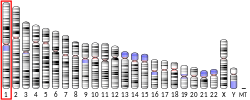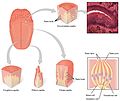receptor type 1 member 2 is a protein that in humans is encoded by the TAS1R2 gene. The sweet taste receptor is predominantly formed as a dimer of T1R2...
13 KB (1,637 words) - 17:37, 25 August 2024
families:[citation needed] Type 1, sweet, first characterized in 2001: TAS1R2 – TAS1R3 Type 2, bitter, first characterized in 2000: In humans there are...
42 KB (4,345 words) - 16:41, 19 June 2024
TAS1R1+3 and sweet taste receptor TAS1R2+3. This receptor is formed as a protein dimer with either TAS1R1 or TAS1R2. Experiments have also shown that...
12 KB (1,547 words) - 17:34, 25 August 2024
lack the TAS1R2 protein, one of two required for function of the sweetness sensory receptor. This is due to a deletion in the relevant gene (Tas1r2) causes...
20 KB (2,385 words) - 18:31, 5 June 2024
individuals for the umami taste. Another interesting quality of the TAS1R1 and TAS1R2 proteins is their spontaneous activity in the absence of the extracellular...
10 KB (1,285 words) - 02:24, 29 November 2023
water tastes slightly sweet to humans, with the effect mediated by the TAS1R2/TAS1R3 taste receptor. Rats given a choice between distilled normal water...
84 KB (9,923 words) - 20:51, 2 September 2024
It has an intense sweet taste because it stimulates the sweet receptor TAS1R2+TAS1R3 in humans, although this is species-dependent, as the equivalent...
9 KB (869 words) - 05:22, 3 December 2023
binding of the heterodimer G protein-coupled receptor formed by the proteins TAS1R2 and TAS1R3. Rodents do not experience aspartame as sweet-tasting, due to...
61 KB (5,683 words) - 23:38, 21 August 2024
washing, or coating themselves in their own urine. Megabats possess the TAS1R2 gene, meaning they have the ability to detect sweetness in foods. This gene...
123 KB (13,410 words) - 09:23, 28 June 2024
Q9BW92 16287 TARS3 HGNC:24728 A2RTX5 16288 TAS1R1 HGNC:14448 Q7RTX1 16289 TAS1R2 HGNC:14905 Q8TE23 16290 TAS1R3 HGNC:15661 Q7RTX0 16291 TAS2R1 HGNC:14909...
242 KB (17 words) - 23:17, 27 April 2024
Taste receptor, type 1, member 1 (TAS1R1) Taste receptor, type 1, member 2 (TAS1R2) Taste receptor, type 1, member 3 (TAS1R3) Class C Orphan receptors GPR158...
4 KB (251 words) - 19:09, 28 June 2022
TR.2, see Orenda Engines TR2, a postal district in the TR postcode area TAS1R2, a taste receptor Temple Run 2 Westinghouse TR-2 research reactor operated...
839 bytes (152 words) - 21:34, 9 March 2021
saltiness, sourness, bitterness, sweetness, and umami, are the cell-bound GPRs TAS1R2/TAS1R3, TAS1R1/TAS1R3, and multiple subtypes of TAS2R for sweetness, umami...
59 KB (7,458 words) - 19:14, 27 March 2024








